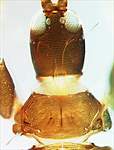
ater

disjunctus

simplicipennis

simplicipennis Mac. thorax & pelta

simplicipennis Mic. thorax & pelta

disjunctus metanotum & pelta

disjunctus antenna

simplicipennis antenna

disjunctus prosternites

simplicipennis prosternites

ater male tergites IX-X

disjunctus female

simplicipennis male sternite VIII
Generic diagnosis
Small to medium, dark, macropterous or micropterous Phlaeothripinae with dark setae. Head usually longer than wide, genae weakly convex, postocular setae long; mouth-cone long or short; maxillary stylets usually not retracted as far as postocular setae, and rarely close together. Antennae 8-segmented; segment III with one sense cone, IV with 3 (+1) sense cones (rarely only 2); VIII usually short and not sharply constricted from VII. Pronotum transverse, with 4 (rarely 5) pairs of major setae; notopleural sutures complete. Prosternal basantra absent; ferna well developed; mesopresternum usually absent medially; metathoracic sternopleural sutures present but sometimes weak. Fore tarsal tooth absent in both sexes. Fore wings not constricted medially, with or without duplicated cilia. Pelta triangular; tergites II‒VII each with two pairs of sigmoid wing-retaining setae; tergite IX setae S1 and S2 usually long and pointed. Male tergite IX setae S2 shorter and stouter than S1; sternite VIII with pore plate.
Nomenclatural data
Teuchothrips Hood, 1919: 86. Type species Teuchothrips simplicipennis Hood, 1919, by original designation.
There are 24 species listed in this genus (ThripsWiki, 2022).
Australian species
Teuchothrips acripilus (Karny, 1920: 39)
Teuchothrips ater (Girault, 1927: 2)
Teuchothrips badiipennis Hood, 1919: 87
Teuchothrips burroughsi (Girault, 1929: 29)
Teuchothrips clavipilus (Karny, 1920: 39)
Teuchothrips connatus (Hood, 1918: 135)
Teuchothrips disjunctus (Hood, 1918: 134)
Teuchothrips froggatti (Bagnall, 1924: 637)
Teuchothrips longiseta (Girault, 1926: 1)
Teuchothrips melaleucae (Girault, 1926: 1)
Teuchothrips minor Bagnall, 1929: 193
Teuchothrips simplicipennis Hood, 1919: 87
Teuchothrips sodalis Bagnall, 1929: 190
Relationship data
This genus is closely related to Liothrips and the species involved share most character states. At present, Liothrips species are distinguished by the presence of all five pairs of elongate pronotal major setae. Sunaitiothrips is also closely related, but has the head curiously parallel-sided.
Distribution data
Of the 24 species listed in this genus 13 are from Australia, mainly from Queensland but with two of these also found in New Zealand. A further five species are known only from New Caledonia, although one of these pacificus Bianchi will be transferred to Neocecidothrips by Mound & Goldarazena (2022). The remaining species listed under Teuchothrips (ThripsWiki, 2022) are from southeast Asia.
Biological data
The species of this genus feed and breed on green leaves, and commonly induce leaf galls. There appear to be many undescribed species in Australia. However, their identification is particularly confusing due to variation in body structure and chaetotaxy within and between populations, and even the number of sense cones on antennal segment IV sometimes differing between the left and right antennae. The genus is widespread across Australia, with disjunctus a minor horticultural pest on Calistemon leaves, and ater also widespread inducing leaf-roll galls on Pittosporum and Bursaria leaves.
References
Mound LA (2008) Identification and host associations of some Thysanoptera Phlaeothripinae described from Australia pre-1930. Zootaxa 1714: 41–60.
Mound LA & Goldarazena A (2022) Antennal sense cone variation in Teuchothrips species of New Caledonia, with one new generic combination (Thysanoptera, Phlaeothripinae). Zootaxa [in press]
ThripsWiki (2022) ThripsWiki - providing information on the World's thrips. Available from: http://thrips.info/wiki/ (Accessed 15.iii.2022)